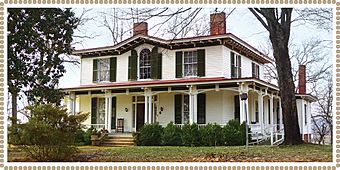Mabry–Hazen House facts for kids
Quick facts for kids |
|
|
Joseph Alexander Mabry Jr. House
|
|
 |
|
| Location | 1711 Dandridge Ave. Knoxville, Tennessee |
|---|---|
| Built | 1858 |
| Architectural style | Italianate, Greek Revival |
| NRHP reference No. | 89001974 |
| Added to NRHP | November 13, 1989 |
The Mabry–Hazen House is a special old home in Knoxville, Tennessee. It sits on a hill called Mabry's Hill. When it was built in 1858, it was named Pine Hill Cottage. The house was in a different town back then, called East Knoxville.
This house looks interesting because it mixes two styles: Italianate and Greek Revival. Over the years, especially in 1886, parts of the house were made bigger. Today, the Mabry–Hazen House is a museum. It still has all its original furniture and family items. There are over 2,000 old artifacts on display. This makes it one of the largest family collections still in its original home in America! The house is listed on the National Register of Historic Places, which means it's an important historical site.
Contents
A Home During the Civil War
The Mabry–Hazen House has a rich history, especially during the American Civil War. The first owner, Joseph Mabry II, was a rich merchant in Knoxville. He helped the Confederate army by providing money for soldiers' supplies. Because of this, he was given the honorary title of General.
During the war, both Union and Confederate soldiers used the house. It was in a very important spot next to Fort Hill. In 1861, Confederate General Felix Zollicoffer even used the house as his main office. Later, Union forces took control of Knoxville. They made the grounds around the house stronger as part of their defenses.
From Family Home to Museum
After Joseph Mabry II passed away in 1882, his daughter Alice Evelyn Mabry and her husband Rush Strong Hazen lived in the house. Their youngest daughter, Evelyn Hazen, lived there by herself for many years. She had many pet dogs and cats!
Evelyn Hazen lived in the house until she passed away in 1987. In her will, she said the house had to become a museum. If not, it would have to be torn down. Luckily, the house opened as a museum in 1992. This way, everyone can learn about its history and see the amazing family collections.
Confederate Cemetery
Near the Mabry–Hazen House is the Confederate Cemetery, also known as Bethel Cemetery. It's a large area where about 1,600 Confederate soldiers are buried. There are also 50 to 60 Union soldiers, who were prisoners, and 20 other veterans buried there.
In 1892, a tall monument was built in the cemetery. It's a 48-foot-high stone pillar made of Tennessee marble. On top of it is a statue of a Confederate soldier looking north. The cemetery also has a small caretaker's house, built around 1881, called the Winstead Mansion.
The House in Books
The people who lived in the Mabry–Hazen House have appeared in famous books.
- In Life on the Mississippi, author Mark Twain wrote about an event that involved Joseph Mabry II and his son, Joseph III.
- Mabry's daughter, Alice, married Rush Strong Hazen. He helped a woman named Leonora Whitaker Wood. Her life story was turned into the novel Christy.
- In 2007, author Jane Van Ryan wrote a book about Evelyn Hazen. It told the story of a legal case between Evelyn and a man she was once going to marry.



